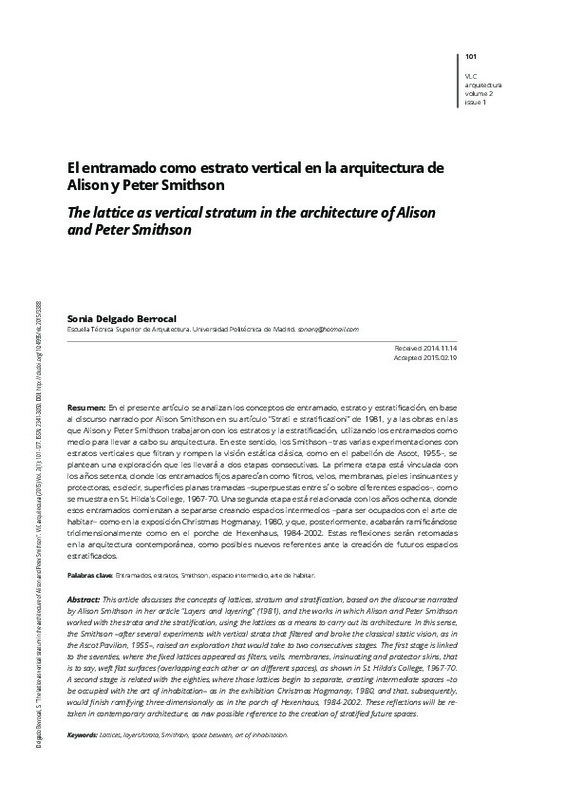|
Resumen:
|
[EN] This article discusses the concepts of lattices, stratum and stratification, based on the discourse narrated by Alison Smithson in her article “Layers and layering” (1981), and the works in which Alison and Peter ...[+]
[EN] This article discusses the concepts of lattices, stratum and stratification, based on the discourse narrated by Alison Smithson in her article “Layers and layering” (1981), and the works in which Alison and Peter Smithson worked with the strata and the stratification, using the lattices as a means to carry out its architecture. In this sense, the Smithson –after several experiments with vertical strata that filtered and broke the classical static vision, as in the Ascot Pavilion, 1955–, raised an exploration that would take to two consecutives stages. The first stage is linked to the seventies, where the fixed lattices appeared as filters, veils, membranes, insinuating and protector skins, that is to say, weft flat surfaces (overlapping each other or on different spaces), as shown in St. Hilda's College, 1967-70. A second stage is related with the eighties, where those lattices begin to separate, creating intermediate spaces –to be occupied with the art of inhabitation– as in the exhibition Christmas Hogmanay, 1980, and that, subsequently, would finish ramifying three-dimensionally as in the porch of Hexenhaus, 1984-2002. These reflections will be re-taken in contemporary architecture, as new possible reference to the creation of stratified future spaces.
[-]
[ES] En el presente artículo se analizan los conceptos de entramado, estrato y estratificación, en base al discurso narrado por Alison Smithson en su artículo “Strati e stratificazioni” de 1981, y a las obras en las que ...[+]
[ES] En el presente artículo se analizan los conceptos de entramado, estrato y estratificación, en base al discurso narrado por Alison Smithson en su artículo “Strati e stratificazioni” de 1981, y a las obras en las que Alison y Peter Smithson trabajaron con los estratos y la estratificación, utilizando los entramados como medio para llevar a cabo su arquitectura. En este sentido, los Smithson –tras varias experimentaciones con estratos verticales que filtran y rompen la visión estática clásica, como en el pabellón de Ascot, 1955–, se plantean una exploración que les llevará a dos etapas consecutivas. La primera etapa está vinculada con los años setenta, donde los entramados fijos aparecían como filtros, velos, membranas, pieles insinuantes y protectoras, es decir, superficies planas tramadas –superpuestas entre sí o sobre diferentes espacios–, como se muestra en St. Hilda’s College, 1967-70. Una segunda etapa está relacionada con los años ochenta, donde esos entramados comienzan a separarse creando espacios intermedios –para ser ocupados con el arte de habitar– como en la exposición Christmas Hogmanay, 1980, y que, posteriormente, acabarán ramificándose tridimensionalmente como en el porche de Hexenhaus, 1984-2002. Estas reflexiones serán retomadas en la arquitectura contemporánea, como posibles nuevos referentes ante la creación de futuros espacios estratificados.
[-]
|








